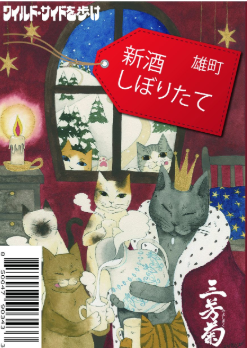
Sake Trend January Newsletter - Partnership with Hellosake app!
Sip Into the New Year with Sake!
Ring in the New Year with a splash of Sake! It’s a rice-tastic way to toast. Try new flavors and let your taste buds dance. Life’s too short for boring drinks—give your celebrations a kick! Cheers to fresh sips and new adventures!
![]() Exciting News!
Exciting News! ![]()
We’re thrilled to announce a partnership between Sake Trend and the Hello Sake App! 🎉
Discover, learn, and enjoy sake like never before with the Hello Sake app – your personal guide to the world of sake. Whether you're a seasoned connoisseur or a curious beginner, this app offers:
🍶 Sake recommendations tailored to your taste
📖 Educational content about sake brewing, types, and pairings
📍 Event updates and exclusive offers
We’re proud to collaborate with Hello Sake to bring the richness of sake culture right to your fingertips.
📲 Download the Hello Sake app today and elevate your sake journey!
Stay tuned for more exciting updates! 🥂
Special Offer
Get free shipping when you order 3 bottles or more from the HelloSake app.
Every purchase enters you into a lottery for a chance to win a complimentary bottle.
Hurry! Offer ends tomorrow. January 20, 2025
Lastly, we appreciate your ongoing support and look forward to serving you even better. See you soon!
---------------------------------------------------

Miyoshikiku: Characteristics and Brewing Methods
by Toji Ryoichiro Mamiya
Sake Trend recently had the incredible opportunity to contribute as a translator during Namazake Paul's Virtual Brewery tour last December. It was an honor to assist Brew-Master Mamiya from Miyoshikiku Sake Brewery in Tokushima Prefecture. The insights I gained from him were invaluable, and I'm eager to share these lessons with you. Together, we can explore the world of sake and unlock its secrets!
Many customers may perceive the defining feature of Miyoshikiku sake to be its sweetness. However, the truth is that the aim of their brewing process is slightly different,
Toji Mamiya's ultimate goal is to achieve a beautiful harmony between water, alcohol, and flavor components. His vision is to craft sake that can be savored without any sharpness from alcohol. He emphasizes how important it is to Miyshikiku Sake Brewery that his sake aligns with the modern palate. While this is certainly an aspiration, it’s important to recognize that Miyoshikiku represents a meaningful step toward that ideal, rather than the finished product. Together, they are on a journey toward creating an exceptional experience for everyone.
To achieve this kind of sake, he considered various factors, starting with yeast. Toji Mamiya developed Tokushima Prefecture yeast, which produces a significant amount of aroma, not just in the initial nose but also in its aftertaste. While the aroma is rich, sweet, and intense, it would be a missed opportunity if the flavor didn’t complement it. This led him to reimagine how he handles the koji-making process.
His overall brewing approach is the complete opposite of conventional ginjo-style brewing. Tokushima yeast is generally weaker, so he ferments at unusually high temperatures to the point of early vigorous activity. The koji for the first and second additions is made to fully dissolve through a process called sohaze koji. Even for the final addition, he maintains relatively high temperatures during fermentation.
Tokushima yeast is inherently low-acidity. With experienced toji, (master brewers), this yeast might produce clean sakes with very low acidity level. Instead, He intentionally raises the fermentation temperature and dissolve the koji to elevate the acidity. For this yeast, forcing it to produce acids other than the typical lactic acid found in traditional sake results in the release of malic acid and other fruit-like acids like succinic Acid.
Malic acid imparts a refreshing acidity reminiscent of green apples, adding a bright and lively character to the sake's flavor profile and Succinic acid plays a role as a key umami component. It adds richness and depth to the flavor profile, often perceived as a "mellow acidity" that enhances the overall taste experience.
This is the hallmark of Miyoshikiku’s brewing style.
Another key aspect is managing the moromi (fermentation mash) duration. He attaches speakers to the sake tanks and plays his favorite rock'n' roll songs during fermentation. A big fan of Lou Reed, he even labeled one of his sake bottles with the phrase *"Walk on the Wild Side."* Mamiya-san is considered a maverick in the sake industry. While most brewers collaborate and work together, he chose not to follow that path. Unlike many sake brewers who graduated from Tokyo University of Agriculture and pursued traditional sake-making methods, he didn’t take that route. His focus was solely on crafting the sake he truly wanted to create, driven by his unwavering passion for brewing.
Ultimately, it is the yeast that brews the sake, and his role as a toji is to create the optimal environment for fermentation.
This balance between tradition and innovation forms the essence of Miyoshikiku Sake Brewery

|
|
|
